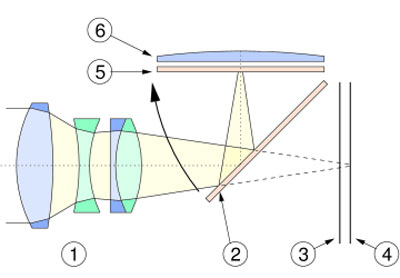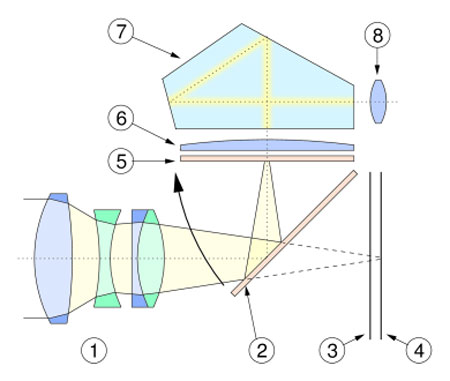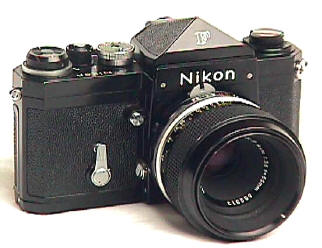Digital Photography from 20,000 Feet
by Wesley Fink on September 25, 2006 12:05 AM EST- Posted in
- Digital Camera
Why the Digital SLR?
SLR cameras have been around for more than 50 years, but it is remarkable how many of those shopping for a digital camera have no idea why the market is moving to the SLR or Single Lens Reflex. Up until the late 1940's the world of hobbyist photography was ruled by 35mm point-and-shoot and rangefinder cameras. These cameras were not really that different from the point-and-shoot cameras that we have today in digital photography, except that they did not have the benefit of all the electronics that are part of today's digital cameras. The cheap point-and-shoots used a fixed focus lens, which meant the lens always shot a certain range (depth-of-field) in focus - no matter whether the subject was in that range or not. The better of these cameras used rangefinders, which were two images from two optics superimposed in the viewfinder. When these two images merged in the viewfinder your subject was in focus. As you can imagine the optics to allow focusing were pretty complicated and expensive to build. However, with a fixed lens that never changed it was possible to design and manufacture some very reliable and affordable rangefinder cameras.
The top end of the amateur photography market, which had embraced 35mm as the "miniature" film standard, then introduced a brilliant idea. Why not manufacture cameras that could use multiple lenses. This would allow the photo hobbyist to use the lens that was best suited for what they were photographing - like a wide-angle lens for interiors, or a telephoto for sporting events and far away subjects. Companies like Leica and Contax pioneered these interchangeable lens rangefinder cameras in the 1930s. After World War II, German camera companies resumed camera manufacturing. Japan, which had manufactured quality optics for a more limited market before WWII, also began making quality interchangeable lens rangefinders. Japanese companies like Canon, Aries, and Nikon championed cameras with changeable lenses.
The ability to change lenses was a great idea, but the execution was anything but simple. Viewfinders started having multiple frames engraved for the different focal lengths like 35mm, 50mm, 85mm. The user had to remember that the tiny square was 85mm. Leica and others had accessory viewfinders that mounted on the flash shoe so you could see about what the lens saw. The problem with the rangefinder is that the viewfinder and the lens never see the same thing. This was not a huge issue with a fixed lens, since the viewfinder could be matched reasonably well to the lens. There were even complicated mechanics that adjusted the viewfinder for "parallax error" on rangefinder close-ups. But with interchangeable lenses the situation became very complicated.

The first popular solution to this problem was the German Exacta, fist produced in 1936. The Exacta had a waist level-finder and a flipping 45-degree mirror. With a flipping mirror, you could look through the lens for composition and focusing - seeing the same view as the lens. You looked at the image from above the camera (5), the image was backwards (as in a mirror image), and the mirror was either manually reset or later reset automatically when winding the film, but the view on the ground glass was the same as any lens (1) mounted on the camera.
In the 1950's the Japanese pioneered further development of the SLR design. A roof pentaprism first appeared on an East German Contax S announced in 1949, but the Japanese camera industry refined and perfected the idea. Asahi developed the Asahiflex in 1952, and in 1954 the Asahiflex IIB. In 1957, Asahi Pentax introduced the fixed pentaprism and the right-hand thumb wind lever. Minolta introduced their first SLR, the SR-2, in 1958. Nikon, Canon and Yashica introduced their first SLRs in 1959 (the F, Canonflex, and Pentamatic, respectively).

The diagram shows how the light passes through the SLR lens assembly (1), is reflected by the mirror (2) and projected on the matte focusing screen (5). Using a condensing lens (6) and internal reflections of the mirrored roof pentaprism (7) the image appears in the eyepiece (8). When an image is taken, the mirror flips up as the arrow indicates, the shutter (3) opens, and the image is projected onto the film or digital sensor (4) The image at the film or sensor is exactly the same as on the focusing screen. [Image from Wikipedia.]
By the early 1960s the basic form of the SLR had evolved to what we know today, as you can see in this photo of the original Nikon F SLR.

Refinements have continued to expand the usefulness of the SLR design. The Topcon RE Super and Asahi Pentax Spotmatic pioneered through the lens metering in the early 60's. Auto exposure was first seen in the Pentax Spotmatic F in 1971, and it was popularized with the Canon AE-1 Program in 1976. Pentax made a limited attempt at autofocus in 1981 with a 35-70 f2.8 lens for the Pentax ME-F. A few years later, Minolta brought out the first real autofocus camera, the MAXXUM 7000, in 1985. The autofocus auto-everything Maxxum 7000 was wildly popular and made autofocus a virtual requirement on future SLR designs.
SLR cameras have been around for more than 50 years, but it is remarkable how many of those shopping for a digital camera have no idea why the market is moving to the SLR or Single Lens Reflex. Up until the late 1940's the world of hobbyist photography was ruled by 35mm point-and-shoot and rangefinder cameras. These cameras were not really that different from the point-and-shoot cameras that we have today in digital photography, except that they did not have the benefit of all the electronics that are part of today's digital cameras. The cheap point-and-shoots used a fixed focus lens, which meant the lens always shot a certain range (depth-of-field) in focus - no matter whether the subject was in that range or not. The better of these cameras used rangefinders, which were two images from two optics superimposed in the viewfinder. When these two images merged in the viewfinder your subject was in focus. As you can imagine the optics to allow focusing were pretty complicated and expensive to build. However, with a fixed lens that never changed it was possible to design and manufacture some very reliable and affordable rangefinder cameras.
The top end of the amateur photography market, which had embraced 35mm as the "miniature" film standard, then introduced a brilliant idea. Why not manufacture cameras that could use multiple lenses. This would allow the photo hobbyist to use the lens that was best suited for what they were photographing - like a wide-angle lens for interiors, or a telephoto for sporting events and far away subjects. Companies like Leica and Contax pioneered these interchangeable lens rangefinder cameras in the 1930s. After World War II, German camera companies resumed camera manufacturing. Japan, which had manufactured quality optics for a more limited market before WWII, also began making quality interchangeable lens rangefinders. Japanese companies like Canon, Aries, and Nikon championed cameras with changeable lenses.
The ability to change lenses was a great idea, but the execution was anything but simple. Viewfinders started having multiple frames engraved for the different focal lengths like 35mm, 50mm, 85mm. The user had to remember that the tiny square was 85mm. Leica and others had accessory viewfinders that mounted on the flash shoe so you could see about what the lens saw. The problem with the rangefinder is that the viewfinder and the lens never see the same thing. This was not a huge issue with a fixed lens, since the viewfinder could be matched reasonably well to the lens. There were even complicated mechanics that adjusted the viewfinder for "parallax error" on rangefinder close-ups. But with interchangeable lenses the situation became very complicated.

The first popular solution to this problem was the German Exacta, fist produced in 1936. The Exacta had a waist level-finder and a flipping 45-degree mirror. With a flipping mirror, you could look through the lens for composition and focusing - seeing the same view as the lens. You looked at the image from above the camera (5), the image was backwards (as in a mirror image), and the mirror was either manually reset or later reset automatically when winding the film, but the view on the ground glass was the same as any lens (1) mounted on the camera.
In the 1950's the Japanese pioneered further development of the SLR design. A roof pentaprism first appeared on an East German Contax S announced in 1949, but the Japanese camera industry refined and perfected the idea. Asahi developed the Asahiflex in 1952, and in 1954 the Asahiflex IIB. In 1957, Asahi Pentax introduced the fixed pentaprism and the right-hand thumb wind lever. Minolta introduced their first SLR, the SR-2, in 1958. Nikon, Canon and Yashica introduced their first SLRs in 1959 (the F, Canonflex, and Pentamatic, respectively).

The diagram shows how the light passes through the SLR lens assembly (1), is reflected by the mirror (2) and projected on the matte focusing screen (5). Using a condensing lens (6) and internal reflections of the mirrored roof pentaprism (7) the image appears in the eyepiece (8). When an image is taken, the mirror flips up as the arrow indicates, the shutter (3) opens, and the image is projected onto the film or digital sensor (4) The image at the film or sensor is exactly the same as on the focusing screen. [Image from Wikipedia.]
By the early 1960s the basic form of the SLR had evolved to what we know today, as you can see in this photo of the original Nikon F SLR.

Refinements have continued to expand the usefulness of the SLR design. The Topcon RE Super and Asahi Pentax Spotmatic pioneered through the lens metering in the early 60's. Auto exposure was first seen in the Pentax Spotmatic F in 1971, and it was popularized with the Canon AE-1 Program in 1976. Pentax made a limited attempt at autofocus in 1981 with a 35-70 f2.8 lens for the Pentax ME-F. A few years later, Minolta brought out the first real autofocus camera, the MAXXUM 7000, in 1985. The autofocus auto-everything Maxxum 7000 was wildly popular and made autofocus a virtual requirement on future SLR designs.










81 Comments
View All Comments
silver - Monday, September 25, 2006 - link
I think this is one tidbit that you might write on when you're realy bored. My images are backed up using Verbatim UltraLife Gold DVD-R media. You also need to make sure that they stay cool and dry much as you do with film. They're not as sensitive to humidity but as certainly far more sensitive to heat.Googer - Monday, September 25, 2006 - link
Panasonic is makeing and selling cameras based on good old Leca Lens. If you have a leica lens from any point in the last 55+ years, it will be compatable with a Panasonic/Leica Camera.
Wesley Fink - Monday, September 25, 2006 - link
The Pansonic Lumix DMC-L1 digital SLR uses a Leica lens built with a four thirds mount. This is the new digital only mount pioneered by Olympus. The LMC-L1 is mentioned in the guide.silver - Monday, September 25, 2006 - link
One of my friends has one of these and the images are simply incredible. He states that the Opticla Image Stabilization is simply the best he could find.wilburpan - Monday, September 25, 2006 - link
As someone used to shooting with film cameras, I can say that I still notice some shutter lag when using digital SLRs, even with current models. To write this off as "Virtually none of the lags of early digital cameras remain" is to ignore a real factor when it comes to the use of any camera.To put this another way, if a digital camera website stated that the choice of CPUs was unimportant in buying a computer because all modern day CPUs were fast and powerful enough, the readers of this site probably would bust a gut.
There are also speed issues involved with other uses of a digital camera that need to be addressed. The Nikon D80 takes about 1.4 seconds to store and then display an image after the shutter has been pressed. The speed of this process varies widely from camera to camera. Similar variances in speed and performance come into play when performing tasks such as playback of pictures taken, the time that it takes to process bursts of photos when shooting in continuous mode, etc.
silver - Wednesday, September 27, 2006 - link
Regarding shutter lag, digital cameras will always be slower than film. There's no way around that. My FM2n's have near instantaneous shutter release and are quite the opposite of my admittedly dated Fuji S602. What manufacturers need to do is to have separate power sources (batteries) for lens focusing and camera functions other than CCD/CMOS/memory charging. Obviously this would complicate the camera so they probably aren't considering this option.Wesley Fink - Monday, September 25, 2006 - link
This is where we start to get into questions about what test is real. The file flush time on a Nikon D80 is 2.0 seconds for a fine jpeg and a little less than 3s for a RAW+jpeg. However, you never encounter this becuase of the memory buffering built into the Nikon D80 and every other digital SLR camera. The D80 can do 3 fps for a little over 30 seconds shooting raw+jpeg, and with fine jpeg it can shoot 3fpm until you run out of flash card room or battery.I consider the D80 time of 160ms viewfinder blackout (0.16s), and a less than 0.1s from off to shot negligible for almost any users. Even the Sony, which has a 1 second start-up, is using almost all that time to clean the sensor before shooting, while shot-to-shot is very competitive with the best SLRs around. Some users might be happier if you could turn off the cleaning on start. While this may be very important for some users, it is doubtful that the small differences in recent digital SLR cameras will really be noticable or matter to most users.
dpreview is an excellent and respected digital review site, and I have sent many readers there with their questions. They often come back with more questions than answers, which usually means they found the technical level too far above their skills and needs. We can't be all things in Digital Camera reviews so we will likely err toward the more basic side.
We'll consider your suggestion about start-up times, but I'm not convinced yet.
yacoub - Monday, September 25, 2006 - link
I appreciate your article but I don't know: I think that folks into digital photography, no matter what other hobbies they have, including computer hardware or gaming, are knowledgable enough (or are competent enough to gain the knowledge needed) to make good use of a site like DPReview, which offers about all the info most need to make an intelligent purchase of a digital camera. Plus that being their primary focus (and has been for years), they automatically get much more credibility than a computer hardware site can hope to achieve by writing content basically saying "look we can do this too!" and writing what most good highschool photography classes are teaching today anyway.I guess my question is, why not stay focused on computer component hardware? All branching out does is reduce the chance of the main hardware getting the attention it needs. There are umpteen motherboard, videocard, and RAM reviews and guides yet to be completed or even begun, yet you're going off into digital photography land? That's kind of disappointing. For that hobby there are already many strong resources for folks who are into that, and many more for folks who want a simple pocket-sized point-n-shoot (which is the majority of folks). Why not focus on being the strong resource in computer hardware that folks in this hobby need?
fanbanlo - Monday, September 25, 2006 - link
Maybe AnandTech can explain to use what are the new technology built into the sensor rather than meaningless marketing terms givin to them.Different algorithm used? what's their computational power?
Why shoot RAW? RAW-enabled software review!?
Thx
Heidfirst - Monday, September 25, 2006 - link
For the lower end DSLRs (D50,350D,K100D etc.) I think that you should also review the standard kit lens as the majority of buyers will probably be buying it with the body as a package.By the time that you start hitting EOS30D type level imo most people will probably have lenses already or be buying a better lens than the entry level kit lens. Also if they are paying that for a body they quite probably are reasonably knowledgeable photo enthusiasts & maybe Anandtech isn't going to be the first place that they look for reviews so sticking to the lower end at least initially sounds reasonable to me.
The idea of a standard test scene is interesting but it would have to be reproducible which means in the studio & that means that it's less representative of the conditions in which most people will use them (I imagine that the % of even current DSLR users who shoot in the studio is in single figures & probably low single figures at that).